NSU Newsroom
SharkBytes
Horizons
This version of NSU News has been archived as of February 28, 2019. To search through archived articles, visit nova.edu/search. To access the new version of NSU News, visit news.nova.edu.
This version of SharkBytes has been archived as of February 28, 2019. To search through archived articles, visit nova.edu/search. To access the new version of SharkBytes, visit sharkbytes.nova.edu.
Shark’s unique trek could help save the species
 FORT LAUDERDALE, Fla. — Her name is Jiffy Lube2, a relatively small shortfin mako shark that, like others of her kind, swims long distances every day in search of prey and comfortable water temperatures.
FORT LAUDERDALE, Fla. — Her name is Jiffy Lube2, a relatively small shortfin mako shark that, like others of her kind, swims long distances every day in search of prey and comfortable water temperatures.
But Jiffy Lube2’s travels are making waves among scientists who study sharks.
The 140-pound mako swam 11,000 miles in the past year using a route that researchers at Nova Southeastern University had never seen before: looping the Atlantic twice, going as far north as Nova Scotia and as far south as the Bahamas.
“This is the only shark that’s made this double southerly migration,” said Mahmood Shivji, director NSU’s Guy Harvey Research Institute in Davie, which has tracked a total of 130 sharks since 2008, using satellite tags.
Along the way, Jiffy Lube2 spent a few days lazing along the surface of the Atlantic near Cape Cod, basking in the sun and gorging on passing fish. In the past month, she has spent most of her time between Washington, D.C. and New York City, where water temperatures range from about 65 to 75 degrees, comfortable for the fastest species of shark.
Researchers don’t fully understand why sharks go so far north, but theorize they may be following prey. Though not picky eaters, they commonly gorge on bluefish, tuna, herring, swordfish and loggerhead turtles.
Tracking the sharks might be key to their survival. If researchers can better understand migration patterns, they can lobby for tighter fishing restrictions in the areas the predators seem to favor.
Sharks are critical to the overall balance of the ocean’s ecosystem, keeping the marine population in check, said research scientist Derek Burkholder. Yet worldwide, about 100 million sharks — of all varieties — are killed annually.
Shortfin makos, whose fins are used in a soup that some cultures consider a delicacy, are a step away from being endangered, largely because of overfishing.
Thanks to the satellite tags, which cost about $3,000 apiece, researchers discovered makos tend to return to the Caribbean in the winter and the North Atlantic in summer — the same pattern as tiger sharks and great whites.
Currently, the center is monitoring 19 makos in the Atlantic and 17 more in the Caribbean and Gulf of Mexico. It’s also monitoring dozens of tiger sharks, oceanic whitetip sharks, sand tiger sharks, blue marlin and sailfish. To see all of the tagged sharks under the current study, go to: ghritracking.org.
One of the tiger sharks, named Harry Lindo, traveled more than 27,000 miles, the longest track distance documented for a tiger shark and possibly the longest ever published for a shark, according to Guy Harvey, the renowned artist and conservationist.
“It is truly remarkable,” he said of the shark’s travels.
Jiffy Lube2, who is just under 6 feet long, received her name during a fundraising sponsorship campaign and was initially tagged in May 2014 off Ocean City, Md. From her extensive travels, researchers were able to determine she’s partial to warm water, which isn’t that unusual since that’s where she’ll find plentiful food.
Although makos can dive as deep as 800 feet, Jiffy Lube2 prefers to remain close to the sun-warmed surface. To catch prey, she can swim up to 60 mph in short bursts.
“Based on Jiffy Lube2’s size, she would be eating almost five pounds of fish per day,” said Brad Wetherbee, assistant director of the Guy Harvey Research Institute. “People have the impression that sharks are eating machines, but compared to many bony fishes, they don’t have a very high rate of consumption.”
On other hand, makos have among the highest metabolic rates for sharks because parts of their bodies are heated, and that requires “burning a lot of food,” said Wetherbee, who teaches biological science at the University of Rhode Island.
It’s unlikely Jiffy Lube2 has traveled great distances in search of a male because she’s probably two years away from being old enough to mate, Shivji said.
©2015 Sun Sentinel (Fort Lauderdale, Fla.)
Visit the Sun Sentinel (Fort Lauderdale, Fla.) at www.sun-sentinel.com
Distributed by Tribune Content Agency, LLC.